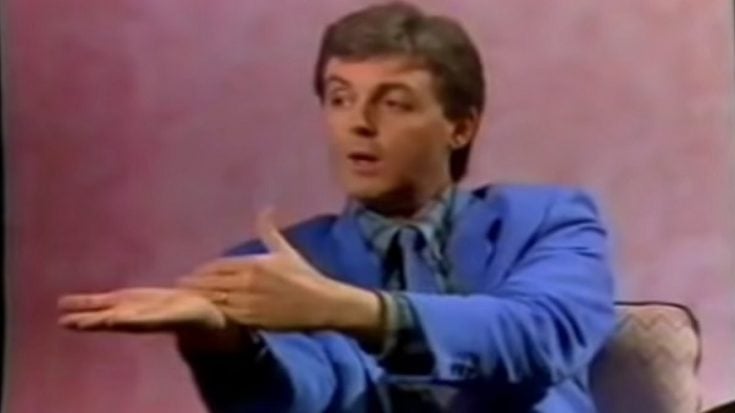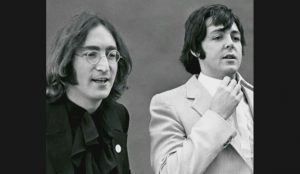Paul McCartney’s Pink Floyd Prediction That Came True

Paul McCartney - Mezatrol University /YouTube
The year was 1967. Psychedelic exploration pulsed through London’s vibrant music scene. The Beatles, already etched in history, were pushing boundaries with Sgt. Pepper’s Lonely Hearts Club Band, a sonic kaleidoscope that redefined pop music.
Meanwhile, four young lads named Syd Barrett, Roger Waters, Nick Mason, and Rick Wright were honing their craft in the same hallowed halls of Abbey Road Studios. Their name: Pink Floyd. On a fateful day, the paths of these two pioneering music titans crossed.
Paul McCartney, the ever-observant Beatle, encountered the nascent Pink Floyd, witnessing their early studio experiments firsthand. Intrigued by their sound, which mirrored the Beatles’ own ventures into sonic experimentation, McCartney was struck by their raw talent and innovative spirit.
McCartney, with his trademark prophetic wit, proclaimed that the upcoming rockstars were a “knockout” after seeing them perform. This simple yet powerful statement wasn’t just a casual compliment; it was a recognition of the immense potential brewing within the young band.
In the presence of their rock idols
In the spring of 1967, a young Pink Floyd, still sporting “the” in their name, were recording their debut album at London’s Abbey Road. Next door, the Fab Four were crafting their masterpiece, Sgt. Pepper’s Lonely Hearts Club Band. Seized by curiosity, Ringo Starr, George Harrison, and Paul McCartney peeked into Pink Floyd’s studio session.
The young band froze, awestruck by the Beatles’ presence. As Roger Waters, Pink Floyd’s bassist and vocalist, recalled, they were “excited by it all”.
Paul, sensing their nervousness, offered encouragement. This encounter, Miles observed, felt like “passing on the mantle” from one generation of musical pioneers to the next.
The Beatles, already pushing boundaries with their own psychedelic explorations, recognized the raw talent and innovative spirit simmering within Pink Floyd. Their visit wasn’t just a friendly gesture; it was a glimpse into the future, a silent acknowledgement of the potential brewing within these young musicians.
The Young Pink Floyd members were blown away by The Fab Four
Waters, in his college days, was already a devoted Beatles fan. But it was a chance encounter in 1967 that truly transformed his musical perspective. The bassist, unable to contain his excitement, recalled listening to the Beatles’ work with “mouth hanging open”, marveling at its completeness and accomplishment.
This experience, he revealed, ignited a sense of creative freedom within him. Inspired by the Beatles’ willingness to express themselves authentically, Waters embraced the notion of artistic self-expression and the value of artistic freedom.
Whether the inspiration was truly one-sided remains a playful debate. Pink Floyd’s manager, Peter Jenner, jokingly suggested that the Beatles were “copying” Pink Floyd’s studio techniques, just as Pink Floyd was influenced by their sonic experiments. McCartney, acknowledging the mutual influence, remarked that “Floyd came in after us … and did a lot of cool experimental stuff.”
This chance encounter at Abbey Road served as a fascinating point of exchange between two burgeoning musical giants. The Beatles’ influence on Pink Floyd’s artistic liberation is undeniable, while the younger band’s innovative spirit undoubtedly pushed the boundaries of both groups’ creative endeavors.
https://twitter.com/BoredWeb3/status/834241806183260161
McCartney acknowledged the greatness in Pink Floyd’s music
Before their fateful encounter with McCartney in the Abbey Road studio, Pink Floyd had already crossed paths with the Beatles. Just weeks earlier, they witnessed the recording of “Lovely Rita”, a glimpse into the professional world they craved.
Pink Floyd drummer Nick Mason recalled being awestruck by the polished sound, yet strangely invigorated. “Oddly confident” despite their inexperience, Mason wrote in his memoir Inside Out, they were inspired rather than intimidated.
This confidence received a boost when they encountered McCartney in the studio. Impressed by their sound, McCartney, in conversation with his friend Barry Miles, saw Pink Floyd as the next step in the evolution of rock music. He described their music as a “synthesis of electronic music, studio techniques, and rock ‘n’ roll”, the very direction the Beatles themselves were exploring.
Miles, recognizing the historical significance of this meeting, saw it as “an acknowledgement of the existence of a new generation of music.” This wasn’t just a compliment; it was a passing of the torch, a validation of Pink Floyd’s potential.
Pink Floyd indeed established their own unmatched legend
Macca’s prediction about Pink Floyd’s potential proved prophetic. The band not only became a “knockout”, but also soared to the forefront of rock’s evolution. Billboard magazine hailed them as “key architects of progressive rock”, leaving “nearly no competition” in their wake.
Their 1973 masterpiece, Dark Side of the Moon, cemented their legendary status. As of early 2024, it had spent a staggering 988 weeks on the Billboard 200, a record unmatched by any album. Its sales exceeded 45 million, surpassing even the Beatles’ Sgt. Pepper’s Lonely Hearts Club Band, and contributing to Pink Floyd’s overall sales exceeding a quarter-billion albums.
The circle of influence came full circle when David Gilmour, Pink Floyd’s lead guitarist and vocalist, forged a close friendship with McCartney, even lending his guitar prowess to three of the ex-Beatle’s solo albums. When asked to pick the “greatest band,” Gilmour, in a display of humility, acknowledged the Beatles’ legacy: “The Beatles were the best.”
This exchange transcends a simple compliment. It reflects the mutual respect and inspiration that fueled the creative journeys of both bands. While Pink Floyd carved their own path, they undoubtedly carried the torch ignited by the Beatles’ pioneering spirit. Their success stands as a testament to the power of influence and the enduring impact of artistic vision.











